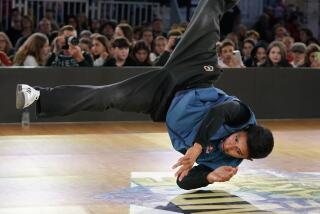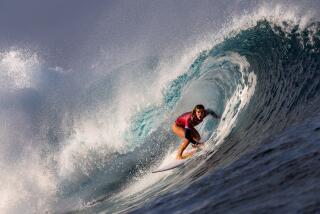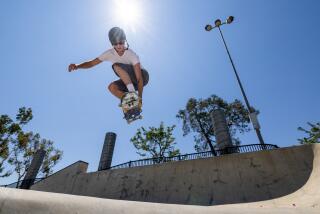Skimboarders See the Sport’s Popularity Swelling
As one of skimboarding’s pioneers flatly admits, his sport is about 25 years behind surfing in terms of popularity. But as skimboarding gains converts each day from other new board sports, Tex Haines believes the gap is closing quickly.
“You only have to look ahead to see skimboarding is a fun sport that has even more potential than surfing, because you can do it almost everywhere,” said Haines, owner of Victoria Skimboards in Laguna Beach.
Similar to surfing, skimboarding takes place closer to shore. The ride starts with a slide across the film of water created by a dying wave. The skimmer follows the water out as it recedes into the ocean, then banks off the next wave and rides it back to shore.
Haines points out that none of skimboarding’s newest, freshwater hot spots can be navigated by a surfboard: sand bars on the Virgin and American rivers in St. George, Utah, and Sacramento, respectively; irrigated baseball fields in Scottsdale, Ariz.; and the banks of Lake Erie in Cleveland.
“Our sport is slowly creeping across the country,” he said. “There’s this merging of the sports going on: water skiing, surfing, wakeboarding, snowboarding. And we’re caught right in the middle of all that.”
No one is more caught up in this convergence than Laguna Beach’s Bill Bryan, a nine-time world skimboarding champion, professional snowboarder and professional surfer.
Bryan’s slender 5-foot-11, 155-pound frame and his wonderful balance and hand-eye coordination allow him to compete professionally in three sports, but his short attention span allows him to excel in only one -- skimboarding.
“Surfing is boring to me,” Bryan said. “If I’m out there surfing for an hour, I may only catch 10 waves. But if I’m skimming, I can run for an hour and catch a hundred waves.”
That hyperactivity comes out a few minutes after Bryan arrives at Laguna’s Aliso Creek Beach, the epicenter of skimboarding. In mid-sentence, he bails on the conversation and streaks toward the surf -- dropping his teardrop-shaped skimboard on the smooth white sand.
Bryan picks up momentum as he glides on a film of water toward a wave that is beginning to flatten out. As he leans back on his 4 1/2-foot-long foam board, he banks off the wave at an angle and twists back toward shore, stopping for a 360-degree spin on his return trip.
He’s only fooling around, but it doesn’t take long to figure out why Bryan is the top skimboarder in the world, according to the final 2002 Skim USA professional rankings.
“He can read the variables in the water and react quicker than most people,” Haines said. “He grew up at the beach, and he’s the lightweight and chalky type. When you’re extending the defiance of gravity as long as possible, being lean helps immensely.”
The contrast between Bryan’s electric rides and the early days of “skimming” is striking. In the 1920s, Laguna Beach lifeguards began skimming on 20-pound round pieces of wood. Today, an estimated 1 million people skimboard on 5-pound pintail-shaped boards (costing anywhere from $175 to $350) using carbon-fiber technology adapted from aerospace to achieve maximum lightness and buoyancy. There is a even a mini-tour and a world championship, held every July at Aliso Creek Beach.
The sport was revolutionized in the early 1980s with the introduction of foam-core boards that propelled riders farther out into the water.
In the early days, riders threw their wood boards at their feet, skimmed along the sand and threw themselves into the waves, with their boards sometimes landing on top of their heads. Back then, before the 360-degree spins and the aerial grabs, just gliding on top of the water was enough of a kick.
“When the water swooshes underneath you, it feels like you’re being jetted along at 35 miles an hour,” said Haines, who started skimboarding when he was 9.
“You feel so strong, there’s so much energy, and you’re moving at such a ridiculous pace that it’s addicting to a little kid.”
Especially one who already knows how to skateboard.
“With waves coming at you from all directions, it feels like a skate park that never stops changing,” said Haines, 50. “It’s also more gentle on the body. Water is a little more forgiving than cement.”
Butch McIntosh, whose Skim Magazine is one of the sport’s main voices -- along with the Web site skimonline.com -- said many of the latest and greatest maneuvers have come from skateboarders.
“Bill Bryan and the other top skimboarders have had to spend a lot of time keeping up with creativity of the skateboarders,” McIntosh said. “Our sport is picking up new foot soldiers every day, and many are skateboarders.”
McIntosh, Bryan and most of the sport’s elite began riding at beaches in Laguna. The spots are prime because of their steep slopes and shore breaks. Beaches such as Huntington and San Onofre are perfect for surfing but terrible for skimming, because the waves break too far out and the beaches are flat.
The slope of the shoreline helps give skimboarders momentum as they push into the water and toward oncoming waves. The rest of the push comes from the legs.
The faster the start, the longer the glide, the better the ride.
For Bryan, the keys are timing and speed.
“Once you get a feel for when the waves are breaking, you run for them like there is a bear chasing you,” said Bryan, 29. “If the conditions are right, you don’t mind doing wind sprints all day long.”
When he isn’t running wind sprints around the competition, Bryan is spreading the skimboarding gospel through a series of videos he produced with his brother, George, the No. 2-ranked rider and a film major at Cal State Long Beach.
Bryan said one of his biggest markets is Japan, where “skimming has become a cult phenomenon.”
Excited as he is about skimboarding’s growth, he hopes the sport learns some lessons from surfing.
“I’m happy to see more competition and a higher level of riding,” he said.
“But one of the best things about skimboarding is that it’s not so cutthroat. The attraction is still having the beach to yourself and a few friends.”


